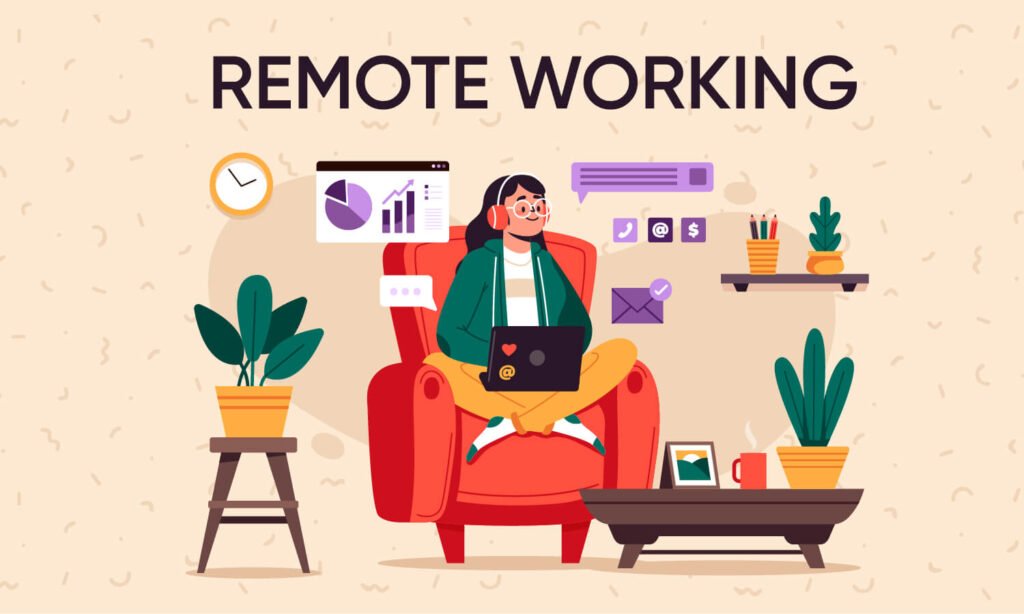8 Essential Rules for Mastering Remote Work Like a Professional
In the absence of traditional workplace frameworks, numerous remote professionals grapple with household distractions, professional isolation, and the erosion of work-life boundaries. Many discover themselves extending their work hours beyond conventional limits, while others confront motivation deficits and procrastination obstacles. The cornerstone of remote work mastery involves cultivating robust systems, establishing clear boundaries, and developing sustainable habits that enable professional excellence in this evolving environment.
Fortunately, implementing strategic approaches allows you to work remotely effectively while preserving mental wellness, maintaining peak productivity, and accelerating career advancement. The eight fundamental principles we’ll examine represent proven methodologies that accomplished remote professionals implement daily to sustain focus, foster meaningful connections, and achieve career satisfaction.
Establish Your Optimal Remote Work Environment
Your physical workspace profoundly influences your cognitive performance and productivity capacity. Designing a purposeful work environment communicates to your mind that it’s time for professional focus and cultivates the mental framework necessary for remote success.
Designate a Dedicated Workspace
Select a specific location within your home that functions exclusively as your professional workspace. This space doesn’t require a complete home office setup—even a designated corner of your living room or a consistent spot at your dining table can be effective when used exclusively for work activities. The critical element is conditioning your brain to connect this location with productivity and professional concentration.
Prioritize Ergonomic Fundamentals
Your physical comfort directly correlates with your capacity to maintain concentration during extended work periods. Quality seating that supports proper posture, a workspace at appropriate height, and sufficient lighting aren’t optional luxuries—they’re fundamental requirements for sustainable remote work performance. Essential ergonomic elements include:
- Supportive seating that maintains proper foot positioning and lumbar support
- Monitor placement at eye level to prevent cervical strain
- Adequate illumination that minimizes visual fatigue
- Comfortable keyboard and mouse for extended usage sessions

Eliminate Environmental Distractions
Home-based work environments contain numerous potential interruptions absent from traditional office settings. Implement proactive measures to reduce these disruptions: relocate mobile devices to separate areas, utilize website blocking applications during focused work periods, and establish clear communication with household members regarding your professional schedule to minimize interruptions.
The objective isn’t replicating a traditional office atmosphere at home—it’s creating an environment that supports your individual work preferences while maintaining the professional concentration required for role excellence.
Excel at Time Management and Productivity Frameworks
Without the inherent structure of office environments, remote workers must develop mastery over their temporal resources. This requires implementing systems that maintain organization, focus, and productivity throughout the workday.
Develop Consistent Daily Routines
Accomplished remote professionals frequently rely on morning rituals that facilitate the transition from personal to professional mindset. These might encompass physical exercise, mindfulness practices, reading, or changing into professional attire. The specific activities hold less importance than their consistency—you’re establishing a ceremony that signals your workday commencement.
Apply Time-Blocking Methodologies
Time-blocking involves assigning specific activities to predetermined time intervals. Rather than operating from basic task lists, you allocate each responsibility to particular calendar slots. This methodology enables you to:
- Distribute appropriate time for various work categories
- Prevent excessive time investment in lower-priority activities
- Establish realistic daily accomplishment expectations
- Incorporate buffer periods for unexpected interruptions or delays
Utilize the Pomodoro Framework
This renowned productivity approach involves concentrated 25-minute work intervals followed by brief rest periods. After completing four cycles, you take an extended break. This technique proves particularly valuable for remote workers because it establishes structure and maintains focus without the natural accountability present in office environments.
Monitor Your Energy Patterns
Observe when you experience peak alertness and concentration throughout your day. Schedule your most demanding or creative work during these high-energy periods, and reserve routine tasks for times when your energy naturally decreases. This self-awareness enables you to work harmoniously with your natural rhythms rather than against them.
Establish Effective Communication Protocols with Your Team
Communication becomes exponentially more critical in remote work settings. Without spontaneous corridor conversations and in-person meetings, you must deliberately maintain team connections and ensure collective alignment on objectives and expectations.
Define Clear Availability Parameters
Establish specific timeframes when you’re accessible for meetings, calls, and immediate message responses. Communicate these hours explicitly to your team and maintain consistent adherence. This prevents the always-available mentality that can lead to burnout while ensuring colleagues understand when they can reach you.
Select Appropriate Communication Platforms
Different communication types require specific tools. Brief inquiries might be best addressed through instant messaging, while complex discussions benefit from video conferences. Establish team protocols for utilizing:
- Email for formal communications and documentation
- Instant messaging for quick questions and status updates
- Video conferences for brainstorming sessions and critical discussions
- Project management platforms for progress tracking and deadline management
Embrace Over-Communication Rather Than Under-Communication
In remote work environments, sharing comprehensive information surpasses minimal communication. Regular updates regarding your progress, challenges, and availability help teams stay informed and prevent misunderstandings. This doesn’t require constant check-ins, but rather strategic communication that maintains team alignment.
Maintain Regular Individual Meetings
Sustain consistent one-on-one meetings with your supervisor and direct reports. These conversations help preserve relationships, address concerns proactively, and ensure priority alignment. The informal feedback and relationship development that occurs naturally in office settings must be intentionally recreated in remote environments.
Establish Boundaries for Optimal Work-Life Integration
One of the most significant challenges remote workers encounter is the difficulty of “leaving work at the office.” When your residence becomes your workplace, establishing clear boundaries that protect personal time and mental well-being becomes essential.
Create Physical Separations
When possible, avoid working from your bedroom or other spaces associated with relaxation and rest. Upon completing work, physically close your laptop and store work materials. This simple action helps create psychological separation between professional and personal time.
Implement Time Boundaries
Define specific start and end times for your workday and maintain consistent adherence. While it’s tempting to extend work hours when at home, this often results in decreased productivity and increased stress. Communicate your working hours to colleagues and family members, and honor these boundaries personally.
Create Transition Ceremonies
Develop specific activities that facilitate your transition from work mode to personal mode. These might include:
- Taking a brief walk around your neighborhood
- Changing into casual attire
- Listening to music or podcasts
- Practicing brief meditation or breathing exercises
- Organizing your workspace
Practice Boundary Setting
Remote work can create temptation to accept additional projects or work during personal time. Practice declining requests that fall outside your working hours or responsibility scope. This boundary establishment protects your time and prevents resentment that can develop when work consistently invades personal time.
The goal isn’t complete work-life separation—it’s creating intentional boundaries that allow full presence in both life areas.
Leverage Technology Tools for Remote Work Excellence
The appropriate technology stack can differentiate between struggling with remote work and excelling in it. Focus on tools that enhance productivity, communication, and organization rather than complicating your workflow.
Master Core Communication Platforms
Develop proficiency with your team’s primary communication tools. This extends beyond basic functionality—learn keyboard shortcuts, advanced features, and integration options that save time and improve efficiency. Whether your team uses Slack, Microsoft Teams, or alternative platforms, your fluency with these tools directly impacts your effectiveness.
Implement Project Management Software
Tools like Asana, Trello, or Monday.com help maintain organization and project visibility. These platforms prove particularly valuable for remote teams because they create transparency around project progress and individual responsibilities. Select a system matching your team’s complexity level and commit to consistent usage.
Develop File Organization Systems
Create clear systems for organizing and accessing digital files. This might include:
- Cloud storage solutions like Google Drive or Dropbox
- Consistent naming conventions for documents and folders
- Regular file cleanup and organization sessions
- Backup systems to protect important work
Optimize Internet and Technology Setup
Invest in reliable internet service and backup options. Consider acquiring mobile hotspot as backup for important meetings or deadlines. Ensure your computer, camera, and audio equipment meet professional standards—these tools are essential for remote work success.
Automate Repetitive Tasks
Identify opportunities to automate routine tasks through tools like Zapier, IFTTT, or built-in automation features in existing software. This might include automatically saving email attachments to specific folders, creating recurring calendar events, or establishing notification systems for important updates.
Build Strong Virtual Relationships with Colleagues
Remote work can feel isolating, but it doesn’t necessitate the end of meaningful workplace relationships. Building strong colleague connections requires intentional effort and creativity in virtual environments.
Participate Actively in Virtual Meetings
Activate your camera during video calls, contribute to discussions, and engage with colleagues’ ideas. Active participation helps maintain visibility and involvement in team dynamics. When you’re consistently engaged, you’re more likely to be included in important conversations and opportunities.
Schedule Informal Virtual Interactions
Recreate casual interactions that occur naturally in office environments by scheduling informal video calls with colleagues. These don’t require length or structure—even 15-minute virtual coffee chats can help maintain personal connections and build rapport.
Share Personal Updates Appropriately
In office environments, personal sharing happens naturally through casual conversations. In remote settings, you must be more intentional about sharing appropriate personal updates that help colleagues know you as a person. This might include:
- Sharing workspace or pet photos during video calls
- Mentioning weekend activities or hobbies in team meetings
- Celebrating personal milestones with your team
- Asking colleagues about their lives and interests
Collaborate on Non-Work Projects
Consider organizing virtual team-building activities, online game sessions, or collaborative projects unrelated to direct work responsibilities. These activities help build personal connections that make remote work more enjoyable and create stronger team bonds.
Demonstrate Generous Recognition and Support
In remote environments, quality work can easily go unnoticed. Make efforts to recognize colleagues’ contributions publicly, offer assistance when possible, and celebrate team successes. This positive approach helps create supportive remote work culture.
Develop Self-Discipline and Accountability Systems
Remote work requires elevated self-discipline compared to traditional office work. Without external accountability structures, you must create personal systems for maintaining motivation and productivity.
Establish Daily and Weekly Objectives
Begin each day with clear objectives and conclude each week with progress reviews. This practice helps maintain focus on important tasks and provides accomplishment satisfaction. Document your goals and reference them throughout the day to maintain focus.
Create Accountability Frameworks
Find methods to create external accountability for your work. This might include:
- Regular check-ins with colleagues or mentors
- Joining remote work accountability groups
- Using applications that track productivity and goals
- Scheduling regular progress reviews with your manager
Develop Consistent Work Habits
Establish routines that support productivity and maintain them even during low motivation periods. This might include starting work at consistent times daily, taking breaks at regular intervals, and following consistent processes for planning and prioritizing tasks.
Practice Self-Compassion
Remote work presents unique challenges, and some days will be more difficult than others. Rather than being overly critical during challenging days, practice self-compassion and focus on returning to track. This balanced approach helps prevent shame spirals that can derail long-term success.
Continuously Evaluate and Adapt
Regularly assess what’s working and what isn’t in your remote work approach. Be willing to experiment with new strategies and adjust systems as needed. What works for you might change over time, and flexibility is key to long-term success.
Optimize Health and Wellness for Remote Success
Your physical and mental health directly impact your ability to work remotely effectively. Without the natural movement and social interaction of office environments, you must be intentional about maintaining well-being.
Prioritize Regular Physical Activity
Prolonged desk sitting can lead to physical discomfort and decreased energy levels. Build movement into your daily routine through:
- Taking walking meetings when possible
- Setting hourly reminders to stand and stretch
- Using standing desks or stability balls for portions of your workday
- Scheduling regular exercise sessions outside work hours
Maintain Social Connections
Remote work can be isolating, especially for individuals who thrive on social interaction. Make efforts to maintain relationships with friends, family, and colleagues outside formal work meetings. This might include virtual lunch dates, phone calls with friends, or participating in online communities related to your interests.
Protect Your Sleep Schedule
Without the natural transition of commuting, it’s easy for work to extend into evening hours and disrupt sleep schedules. Establish consistent bedtime routines and avoid screens for at least one hour before bed. Quality sleep is essential for maintaining focus and energy throughout your workday.
Manage Stress Proactively
Remote work can create unique stressors, from technology challenges to isolation. Develop healthy coping strategies such as:
- Regular meditation or mindfulness practices
- Journaling to process thoughts and emotions
- Engaging in hobbies that promote relaxation and recharging
- Seeking professional support when needed
Maintain Proper Nutrition and Hydration
The convenience of working from home can lead to poor eating habits or constant snacking. Plan healthy meals and snacks, keep water nearby, and avoid eating at your desk when possible. Taking proper meal breaks helps maintain energy levels and provides mental breaks from work.
Begin by implementing one or two strategies that resonate most with you, then gradually build upon your success. Some days will present greater challenges than others, and that’s completely normal. The key is maintaining consistency with your core practices while remaining flexible enough to adjust as needed.
Remote work offers unprecedented opportunities for career growth, work-life balance, and personal fulfillment. By following these guidelines and staying committed to continuous improvement, you can work remotely effectively while building the career and lifestyle you desire. The future of work is remote, and with the right approach, you can thrive in this new professional landscape.



